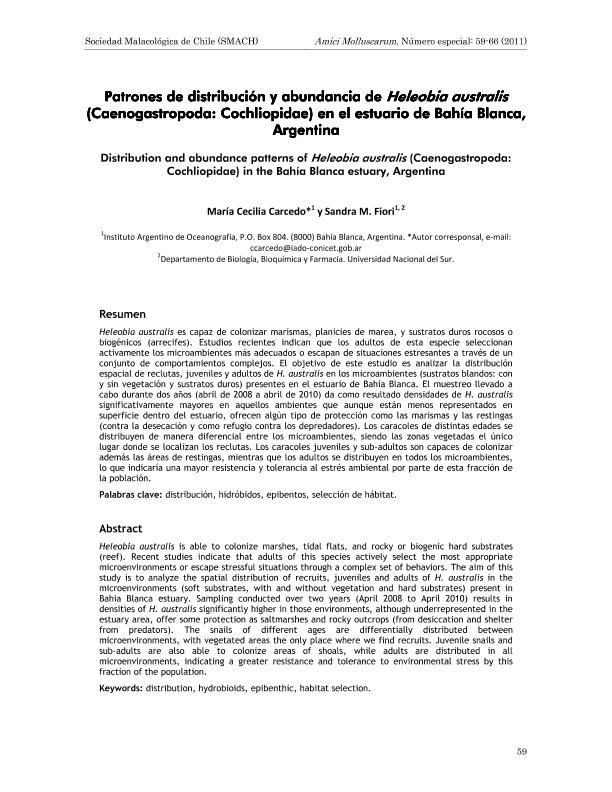Artículo
Heleobia australis es capaz de colonizar marismas, planicies de marea, y sustratos duros rocosos o biogénicos (arrecifes). Estudios recientes indican que los adultos de esta especie seleccionan activamente los microambientes más adecuados o escapan de situaciones estresantes a través de un conjunto de comportamientos complejos. El objetivo de este estudio es analizar la distribución espacial de reclutas, juveniles y adultos de H. australis en los microambientes (sustratos blandos: con y sin vegetación y sustratos duros) presentes en el estuario de Bahía Blanca. El muestreo llevado a cabo durante dos años (abril de 2008 a abril de 2010) da como resultado densidades de H. australis significativamente mayores en aquellos ambientes que aunque están menos representados en superficie dentro del estuario, ofrecen algún tipo de protección como las marismas y las restingas (contra la desecación y como refugio contra los depredadores). Los caracoles de distintas edades se distribuyen de manera diferencial entre los microambientes, siendo las zonas vegetadas el único lugar donde se localizan los reclutas. Los caracoles juveniles y sub-adultos son capaces de colonizar además las áreas de restingas, mientras que los adultos se distribuyen en todos los microambientes, lo que indicaría una mayor resistencia y tolerancia al estrés ambiental por parte de esta fracción de la población. Heleobia australis is able to colonize marshes, tidal flats, and rocky or biogenic hard substrates (reef). Recent studies indicate that adults of this species actively select the most appropriate microenvironments or escape stressful situations through a complex set of behaviors. The aim of this study is to analyze the spatial distribution of recruits, juveniles and adults of H. australis in the microenvironments (soft substrates, with and without vegetation and hard substrates) present in Bahia Blanca estuary. Sampling conducted over two years (April 2008 to April 2010) results in densities of H. australis significantly higher in those environments, although underrepresented in the estuary area, offer some protection as saltmarshes and rocky outcrops (from desiccation and shelter from predators). The snails of different ages are differentially distributed between microenvironments, with vegetated areas the only place where we find recruits. Juvenile snails and sub-adults are also able to colonize areas of shoals, while adults are distributed in all microenvironments, indicating a greater resistance and tolerance to environmental stress by this fraction of the population.
Patrones de distribución y abundancia de Heleobia australis (Caenogastropoda: Cochliopidae) en el estuario de Bahía Blanca, Argentina
Título:
Distribution and abundance patterns of Heleobia australis (Caenogastropoda:
Cochliopidae) in the Bahía Blanca estuary, Argentina
Fecha de publicación:
12/2011
Editorial:
Sociedad Malacológica de Chile
Revista:
Amici Molluscarum
ISSN:
0718-9761
Idioma:
Español
Tipo de recurso:
Artículo publicado
Clasificación temática:
Resumen
Palabras clave:
Distribucion
,
Hiadrobidos
,
Epibentos
,
Habitat
Archivos asociados
Licencia
Identificadores
Colecciones
Articulos(IADO)
Articulos de INST.ARG.DE OCEANOGRAFIA (I)
Articulos de INST.ARG.DE OCEANOGRAFIA (I)
Citación
Carcedo, Maria Cecilia; Fiori, Sandra Marcela; Patrones de distribución y abundancia de Heleobia australis (Caenogastropoda: Cochliopidae) en el estuario de Bahía Blanca, Argentina; Sociedad Malacológica de Chile; Amici Molluscarum; Especial; 12-2011; 59-66
Compartir




